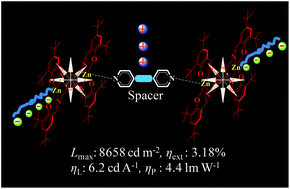Coordination polymers based on bis-ZnII salphen complexes and functional ditopic ligands for efficient polymer light-emitting diodes (PLEDs)†
Abstract
Encouraged by the high photoluminescence (PL) of the bis-ZnII salphen complexes, a series of coordination polymers have been successfully developed through metal–ligand interactions between the bis-ZnII salphen complexes and functional ditopic ligands. These bis-ZnII salphen coordination polymers can exhibit high thermal stability up to 433 °C. Their PL spectra show an emission maximum peaking at ca. 570 nm in solution and ca. 580 nm in neat films. The PL investigation of the neat films for these bis-ZnII salphen coordination polymers has indicated that the functional ditopic ligands can restrain the molecular packing among the bis-ZnII salphen units for enhancing their PL intensity. Hence, the functional ditopic ligands should exhibit great potential in avoiding exciton quenching in the emission layer formed by these bis-ZnII salphen coordination polymers in polymer light-emitting diodes (PLEDs). Benefiting from such a molecular design, these bis-ZnII salphen coordination polymers can exhibit a peak luminance (Lmax) of 8658 cd m−2, a maximum external quantum efficiency (ηext) of 3.18%, a maximum current efficiency (ηL) of 6.2 cd A−1 and a maximum power efficiency (ηP) of 4.4 lm W−1. These attractive results represent the state-of-the-art EL performances ever achieved by Schiff base ZnII coordination polymers, which would provide significant clues for developing high performance PLEDs based on Schiff base ZnII coordination polymers.



 Please wait while we load your content...
Please wait while we load your content...